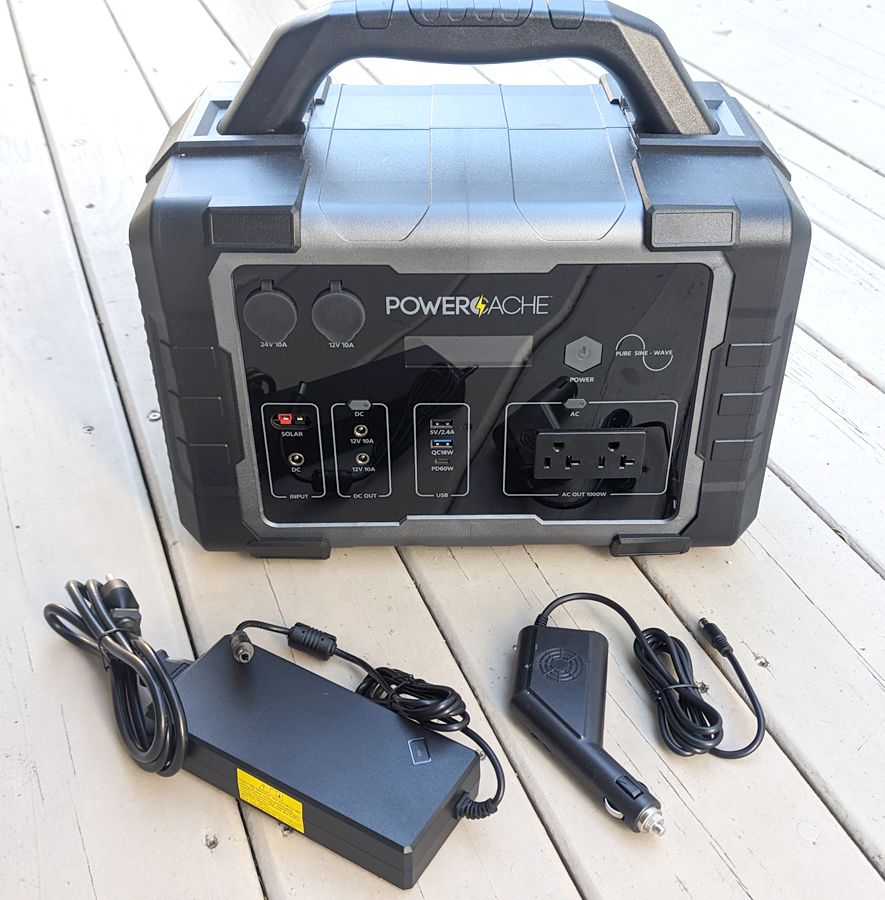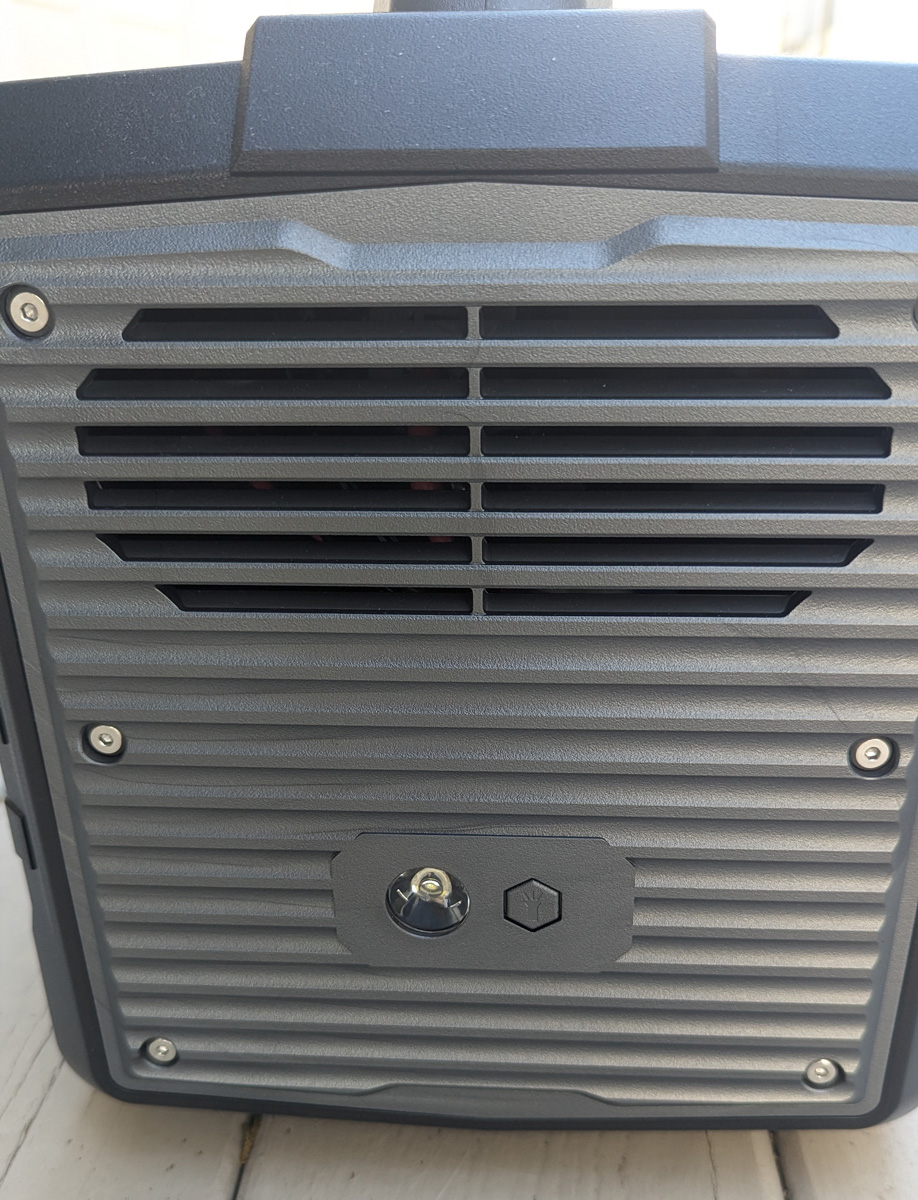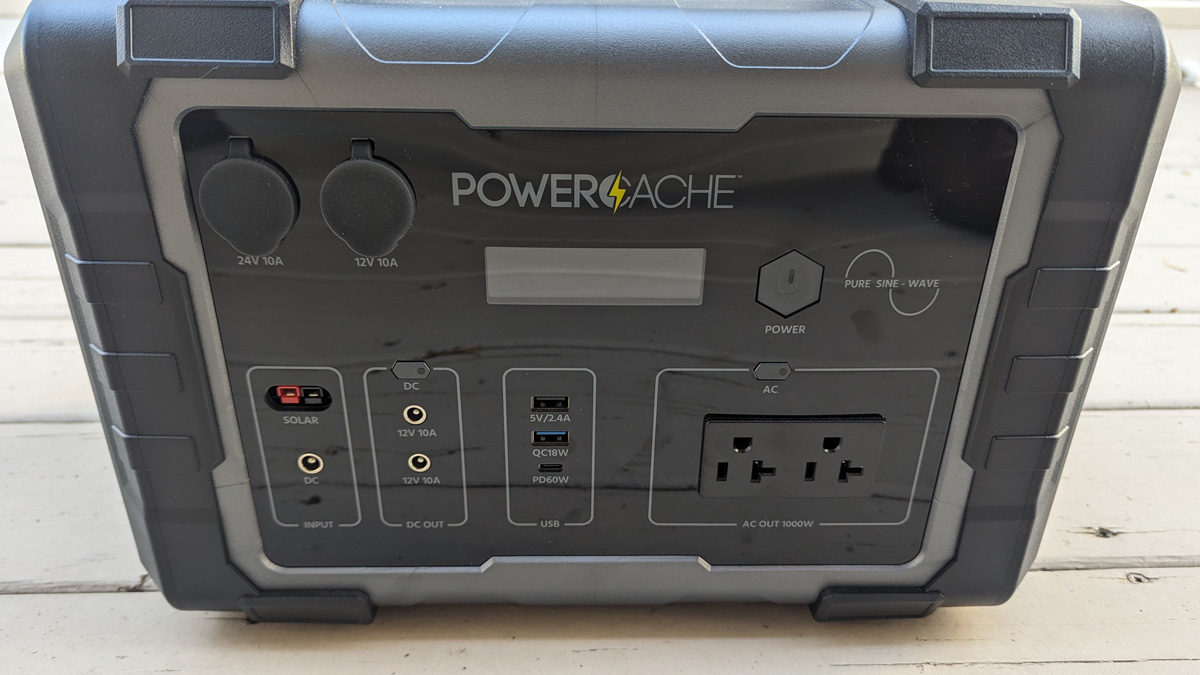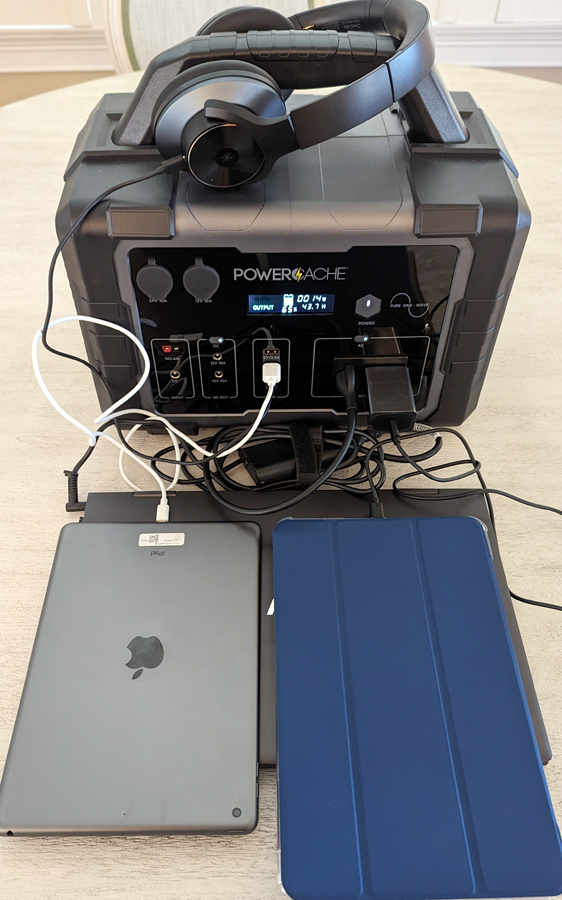REVIEW – I have spoken fondly for many years here at the Gadgeteer about those handy portable power banks and how I have them everywhere, because let’s be honest, you can never have too many, right? But while they are very handy to have around, the vast majority of those types of small power banks aren’t designed to power your refrigerator, or a power saw, or a space heater. So if you want a portable power solution that can get you through a tough winter storm when the power is knocked out, or perhaps gives you power someplace remote that doesn’t have power outlets, you need what is called a ‘power station’. These are robust power solutions that aren’t cheap and are quite heavy, but they can be life savers when you need power to keep you and your gadgets/appliances going when you need them most. I had the chance to review just such a power solution from Monoprice called the Powercache 1000. Let’s check it out!
What is it?
The Monoprice Powercache 1000 is a portable power station that provides you the ability to power 9 devices/gadgets at the same time via various types of connections like AC, DC, USB, etc.
What’s in the box?
- The Powercache 1000
- AC adapter
- DC car charger
- A user manual
Tech specifications
- Output Waveform: Pure sine wave
- Output Voltage: 120V / 60HZ
- Power Output: 1000W continuous / 2000W surge
- Battery Capacity: 1075Wh
- Battery Model: 2V 6000mAh (8S7P) Supports 1C discharging, 0.5C charging
- Battery Type: lithium iron phosphate (LiFePO4)
- DC Output (car ports): 1 port at 24V / 10A, 1 port at 12V / 10A
- DC Output: 2 ports at DC 5525 (Sharing 12V / 10A)
- 3 USB ports:
- 1 port at USB 2.0 5V 2.4A
- 1 port at USB 3.0 QC
- 1 port at PD 60W
- Charging Time: 6 ~ 7H charging with AC plug, 15 ~ 16H with car plug, 4 ~ 5H charging with solar panels
- Voltage and Current: 4V d.c. 3.0A (Supports 29.4V~50V)/Solar Panel 36V 100W-400W
- LED Lighting modes: 3W (Lighting, SOS, Strobe)
- Working Environment Temperature: 32°F ~ 104°F
- Storage Temperature: 14°F ~ 149°F
- Product Dimensions (L x W x H): 84″ x 9.25″ x 12.83″
- Net Weight: 1 lbs
- Electrical Protection Functions: Over-voltage, low-voltage, over-temperature, overload, output short-circuit protection
Features and performance
A word about ‘watts’.
Before I dive into the details of the Powercache 1000, I think it’s important to talk about how these devices work and the terms we use to compare them. It’s helpful to understand this, especially if you have never considered one of these for purchase because they are unlike those little power banks/batteries that we have been using for years.
Those little backup power banks/batteries that we use to charge our cellphones are generally compared to each other based on the size of the battery. You’ll see the term “milliamps”, or “mAh”, listed for each one. For example, if you have an iPhone with a 3,000 mAh internal battery, and you have a power bank that is a 10,000 mAh battery, the power bank can probably charge your cellphone around 3 times before you need to fill the power bank back up. Pretty simple to understand, and marketing departments for years have used this term “mAh” to allow us to compare these types of products to each other. But when it comes to power stations, the terms used are different and can be confusing.
You’ll see power stations rated with the term “watts”, and you won’t see the term “mAh” used anywhere. For example, you’ll see a power station listed with a battery capacity of 1,075W (which, by the way, is what the Powercache 1000 has!). Some of the larger power stations will have even larger capacity, like 1,500W or 2,000W. So what exactly does the “W” (watts) mean? I mean, what you really want to know is how many times you can charge your cellphone, right? So right about now, the savvy geeks among us who understand all this lingo about “mAh” and “watts” are rolling their eyes. And while I am no expert on electricity, I can summarize this for the average/novice geek who is treading into unknown waters with power stations.
The purpose of these larger power stations is to allow you to charge/use larger gadgets and appliances that need lots of power. For example, I have an ebike that has a power supply with a standard three-prong power cord that plugs into my home wall outlets when I want to charge it. That power supply pulls power at a rate of ‘117W’ when plugged up. So if I have a power station that is rated at 1,075W, my power station will only run continuously for around 8-9 hours with a device that is pulling power at 117W before it is dead (1,075 divided by 117). Now, my ebike battery might very well be charged to full in a couple of hours, so it won’t need to pull 117W constantly for 8-9 hours, but you see my point. That’s a very simplified way to explain it, but it is useful because it’s simple math. Another example: if I have a refrigerator that requires 500W to operate, then the Powercache 1000 (with its 1,075W of power) should be able to keep my fridge running for almost 2 hours of continuous use before the power station is dead. That was a long explanation, I know. But it’s very important to understand this if you are going to purchase one of these things because you need to evaluate what you want to potentially power, how much power those devices pull, and how big your power station needs to be to accomplish that.
Ok, let’s dive into the Monoprice Powercache 1000.
Design
The Powercache is about the size of a small duffle bag, but it weighs about 23 lbs, so this thing is heavy. It has a nice handle across the top, which makes carrying around those 23 lbs a little easier. And this gadget is actually lighter than many other power stations, which can run as heavy as 50 lbs or so. It really depends on the size of the battery, but you need to expect that whatever power station you buy is going to be heavy. There is nothing in the way of buttons or anything on the bottom or back or top (besides the handle mentioned above). The left side of the Powercache has a heat vent. On the right side you’ll see a heat vent as well, and 1 button that operates the small LED light that sits right beside the button. Power stations are often purchased to be used with campsites, sheds/outbuildings in the backyard, or on construction job sites, so a light could be handy if you needed one. And most LED lights (like this one) on power stations have the ability to be used as a constant light, or for emergency situations when you want a strobe light or SOS light.
On the front, you’ll see everything else. There is a main power button that turns the Monoprice Powercache 1000 on. You’ll see a digital screen in the middle where you can see everything you need to know when operating the Powercache, like how much power (W) is being pulled, how much battery life is left, how many hours of use you have left (at the current rate that power is being used), how long it will take to recharge the Powercache, etc. (NOTE: I had an issue with this, but I will summarize at the end of this article the problems I had.)
Then you’ll see all the various ports you have available to charge things. For example, in the upper left corner you’ll see 2 ‘cigarette’ lighters (as we used to call them) that you night see in your car. Honestly, I will never be using either of these ports because I haven’t owned anything that requires a port like that in maybe over a decade. But I suppose there are a bunch of gadgets still out there that require these ports.
The Powercache comes with 2 power cables to allow you to charge it up when it’s dead. One power cable is a standard 3-prong that you plug up to your home outlets, and then you connect the other end of the cable to the ‘DC’ port that is labeled as ‘input’ on the front of the Powercache. You can also use this ‘DC’ input with the second cable that came with the Powercache, which is a cable that you can use in your car cigarette lighter. It takes about 6-7 hours to completely charge up the Powercache using the 3-prong cable, but it will take significantly longer to charge the Powercache using the cigarette lighter port in your car. Monoprice says charging the Powercache in your car will take you around 15-16 hrs, and the car needs to be running so that you don’t kill your car battery. Obviously, not ideal. There is also a charging port that can be used to charge the Powercache with solar panels. I don’t have any solar panels, so I couldn’t test that. But Monoprice says that the Powercache can handle up to 400W solar panels.
You’ll see 3 USB ports, 2 of them are USB-A and 1 of them is a USB-C port. One of the USB-A ports is a Quickcharge 3.0 port capable of 18W of power, and the other is an old-school standard USB-A capable of up to 12W of power. The USB-C port is pretty great at 60W of power, but unfortunately there is only 1 USB-C port. There needs to be more of those in my opinion, especially considering that there are so many devices now that can utilize USB-C.
You’ll also see 2 DC ports (those small round ports) that are rated at 12V 10 amps, with a maximum draw capacity of 120W total. Which means you can use one of them to pull 120W if you needed that, but if you use both of those ports at the same time you only have a total of 120W that can be pulled between them. Just like the cigarette lighter ports, I can’t think of any devices/gadgets I have that utilize a DC power connection, so I don’t think I’ll use those 2 ports often.
Finally, the ports that will most likely be used by most folks, including me, are the AC ports, and there are 2 of them. These are your standard 3-prong power plugs that can be used with just about anything that has to be plugged up. I have used them with my cellphone, laptop, a shop clip light, my ebike, my tablets, my Keurig coffee maker, and more. One thing that I noticed right away is that the placement of these AC outlets on the Powercache is not ideal. The 2 outlets are too close together. Some of the power bricks for my gadgets, like my cellphone and tablets, are too wide to be plugged up together to the Powercache. In the picture below you can see one of my tablets plugged up to the right AC outlet and my laptop power cord plugged up to the left AC outlet. It works fine like this because my laptop power cord is a standard 3-prong cable, but if I tried to use my cellphone power brick and my tablet power brick at the same time, I couldn’t, because the power bricks themselves are too wide to be used simultaneously side by side. This is kindof annoying and I have noticed on many other power stations that the AC outlets are spaced further apart.
You’ll also notice right above the section where the DC outlets are and the AC outlets are, there are small buttons that you press to turn on those ports. So even if the Powercache is already turned on, you have to press those buttons to turn on those ports. This is pretty standard with most power stations that I have seen, and they always recommend that you turn those ports off if you aren’t using them.
Performance
As far as charging performance goes, the Powercache power cable that I use to charge it back up using my wall outlets at home draws power from the wall at around 168W. That means that it should take about 6-7 hrs to fully charge the 1,075W battery in the Powercache, and that is right on the money since it takes me right at 6 ½ hrs to charge it up from empty.
As I discussed earlier, the amount of time that the Powercache battery lasts depends on what you plug up to the ports. If you plug lots of smaller gadgets up at the same time, like cellphones, tablets, and laptops, then the Powercache will last a long time, probably days, because those gadgets don’t pull huge amounts of power. But the main reason you would buy one of these things is to do more than just charge your cellphone. So I tested many different devices in my home and provided a laundry list of things below that did and didn’t work with the Powercache. But this is the time to mention some other numbers that you’ll see when purchasing a power station. You’ll see ‘continuous power output’ and ‘surge power output’. So when you first plug up a device/appliance to the Powercache you’ll see a ‘surge’ in power, or what I would also call a ‘spike’. For example, when I plugged up my Keurig coffee maker and turned it on, I saw a spike in the Watts to 1,600W for about 2 seconds. Then it went down to 1,150W when it was operating, heating water. So the Powercache is rated with 1000W continuous output, with a surge output of 2000W, which means as long as the Keurig doesn’t spike over 2000W at startup, it won’t shut off. Now, the Powercache is rated at 1000W continuous output, which means my Keurig shouldn’t work at 1,150W, right? Well, after testing it 5 times in a row, 4 of the 5 times my Keurig worked and the Powercache didn’t shut off. One time it did shut off. Now, I am not an expert in electricity and power (obviously, as the smart geeks among us roll their eyes again), but what I noticed is that sometimes the Powercache still operated even if the total watts being pulled went slightly over the 1000W number. I guess I should then say ‘your performance will vary.’ The good news is the Powercache has built-in protections so that if your device/appliance tries to pull more power than it can handle, it shuts down so the battery isn’t damaged.
Here is the list of the many things that worked/charged, along with the power that each item pulled:
- Shop light in the garage (64W)
- HP laptop (27W)
- Goggle Pixel 6 cellphone (20W)
- Apple iPad (10W)
- E-bike (117W)
- Beside lamp (93W)
- 55 inch TV (158W)
- Toaster (775W)
- Can opener (65W)
- Electric hand mixer (100W)
- Crock pot (260W)
- Upright mixer (450W)
- Small space heater on low (766W)
- Keurig coffee maker (1,150W)
- My kitchen refrigerator (360W) NOTE: when it kicks on the fridge surges/spikes to 1,600W)
There were some things that didn’t work:
- Hair dryer on high heat (1,500W)
- Small space heater on high (1,230W) NOTE: it worked for about 20 seconds before shutting off)
- Corded power tools that require 15A or more. For example, I have a corded circular saw that requires 20A, which correlates to 2,400W, so it would not work with the Powercache.
One thing I do wish that the Powercache had was a wireless charger. Wireless charging has almost become ubiquitous in the tech industry, and there aren’t many power stations that have this, so I hope that Monoprice considers adding one to their power stations in the future.
I should also mention a word about the battery type that is inside the Powercache. This is becoming more important in the tech world, so you should know that the battery is made of lithium iron phosphate (LiFePO4), and not lithium ion, which most folks are used to. Basically, LiFePO4 batteries have a unique chemistry makeup that provides lower voltage than lithium-ion and discharges energy slower than lithium-ion. That also means that LiFePO4 batteries usually last longer and they are much less susceptible to catching on fire, which is peace of mind, am I right? Also, the minerals needed to make them are mined in a more socially conscious way.
Finally, let me mention some problems I had with the Powercache 1000 that could be considered deal breakers for most people. First of all, I had a problem when I plugged up some devices to the Powercache and it would not show on the display how many watts were being pulled and how much charging time was remaining. It was random, so sometimes it worked and sometimes it didn’t. It involved the USB ports and the AC ports. And to add to the weirdness of it all, I could sometimes get the display to show the information if I turned the LED light on the side of the unit on and off. Go figure.
Secondly, I reached out to Monoprice technical support about this issue and after a week I heard back from them to try some basic things like rebooting the device, etc. Nothing worked, so they determined that there might be a faulty driver and they were going to send me a replacement unit. After several more emails over the next couple of months, I still had heard nothing. To this day, crickets. That doesn’t build confidence that when you purchase their product that it will be supported when you need help.
What I like about the Monoprice Powercache 1000 power station
- Portable power when you need it
- Able to power many more devices than the typical power banks that you currently have
- The carrying handle on the top is very convenient to transport it from place to place
- Option for a solar charger
- A LiFePO4 battery
What I would change
- Add 1 more AC port
- AC ports are too close together for some gadget adapters
- Add at least 1 or 2 more USB-C ports
- Add wireless charging
- Sometimes the watts being pulled from devices I had charging did not show up on the display
- Tech support was not helpful at all
Final thoughts
When looking at the multitude of power stations now available out there, the one you go with really will depend on what your needs are. The Monoprice Powercache 1000 is a much more robust solution than those little power banks that you have everywhere to charge your cellphone because this thing can power some small appliances. But if you want a power station to give you what you need to get through a storm that knocks out your power for a couple of days and you need to operate a bunch of household devices/appliances at the same time, this power station isn’t for you because it just isn’t big enough and doesn’t have enough ports. You’ll want to spend a lot more money to get more power and more available ports. However, if you just want a power station to give you the ability to charge all your gadgets (laptop, cellphone, tablets, lamps, etc) for awhile, in a location that perhaps doesn’t have a multitude of power options, or maybe use some small appliances while you wait for the power to come back on, then this power station might be a good choice for you. I do wish it had more USB-C ports and at least 1 more AC outlet, but for the price you pay this is a good general solution to having backup power when you need it. If you need more than that, I would expect to pay between $1,000 and $2,000 for a much larger power station.
Finally, I will say that I have a hard time recommending this power station because of the 2 problems I mentioned at the end of the article. (The watts not showing on the display sometimes and the lack of technical support) When I first received the product to review, it was priced at $799. It is now down to $439 after a few months. Maybe that is indicative of demand falling because of issues like that and word getting out that there are more reliable options in this product space? Who knows. The bottom line is that this space is crowded, and you have lots of choices. The price of the Powercache is very attractive now since they lowered it, but you get what you pay for, right? I guess it’s true that ‘your experience may vary’.
Price: $439.99 (on sale as of the date of this article)
Where to buy: Monoprice
Source: The sample of this product was provided by Monoprice. Monoprice did not have a final say on the review and did not preview the review before it was published.







Gadgeteer Comment Policy - Please read before commenting
While these big batteries with a built in inverter have a purpose, I’ll stick with my comparably priced WEN 2350 Watt generator which served me well last week during hurricane Beryl here in Houston. All week, I ran the fridge, a small window A/C, charged cell phones, had a fan and a few lights on, and ran a 42′ TV with an X-Box. Used a few gallons of gas at 52 decibel noise range.
Something like this battery would have lasted a day, maybe. My daughter has a friend with one of these that came with solar panels. It takes literally forever to charge a big battery with 20 Watt output solar panels so she brings her battery unit into work and changes it on her employer’s dime. LOL!
These units are good for camping out in an RV when you don’t have a generator to power stuff and for home use during a temporary power outage.
Nice write up for those who have limited electrical knowledge.
Capacitors play the following main roles in mobile power stations:
1. Fast power supply: Provide instantaneous high current to meet the needs of device startup or high load.
2. Power smoothing: Reduce current fluctuations and ensure stable power supply.
3. Protect batteries: Buffer current changes and extend battery life.
4. Energy storage: Store energy when the battery is full and release it quickly when needed.
5. Improve efficiency: Improve overall system efficiency by reducing current fluctuations and improving the stability of current output.
I went some electronic exhibition ,collected the top 10 capacitor supplier of China.
1. Nippon Chemi-Con Corporation
2.Shanghai Yongming Electronic Co.,Ltd
3. Nantong Jianghai Capacitor Co., Ltd.
4. Chongqing Capxon Electronic Industrial Co., Ltd.
5. Man Yue Technology Holdings Limited
6. Aihua Group
7. Xiamen Faratronic Co., Ltd.
8. Kemet Corporation (China Division)
9. Guangdong Fenghua Advanced Technology Holding Co., Ltd.
10. Shenzhen Eyang Technology Development Co., Ltd.